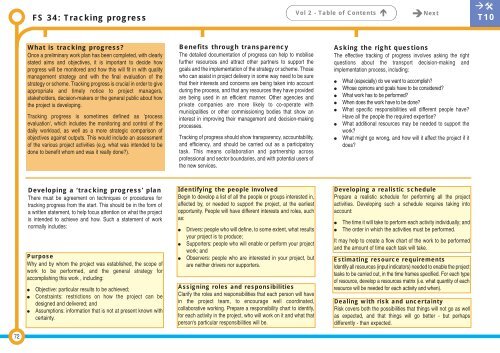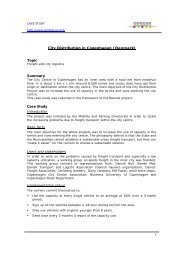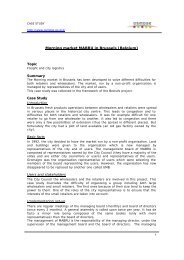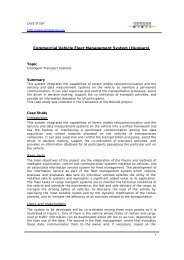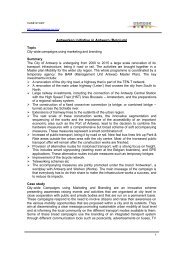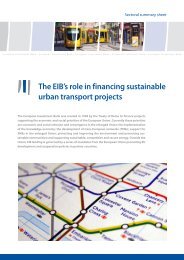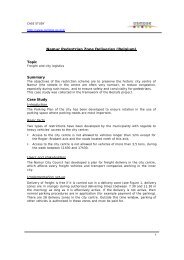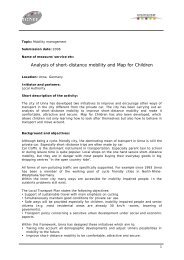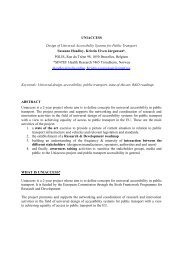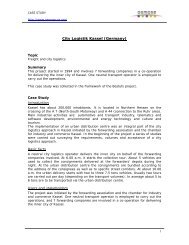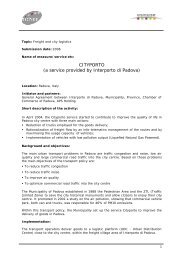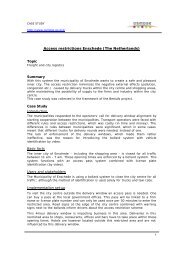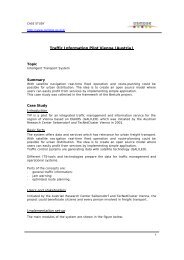Successful transport decision-making - Osmose
Successful transport decision-making - Osmose
Successful transport decision-making - Osmose
You also want an ePaper? Increase the reach of your titles
YUMPU automatically turns print PDFs into web optimized ePapers that Google loves.
FS 34: Tracking progress<br />
Vol 2 - Table of Contents <br />
Next<br />
<br />
T10<br />
What is tracking progress?<br />
Once a preliminary work plan has been completed, with clearly<br />
stated aims and objectives, it is important to decide how<br />
progress will be monitored and how this will fit in with quality<br />
management strategy and with the final evaluation of the<br />
strategy or scheme. Tracking progress is crucial in order to give<br />
appropriate and timely notice to project managers,<br />
stakeholders, <strong>decision</strong>-makers or the general public about how<br />
the project is developing.<br />
Tracking progress is sometimes defined as 'process<br />
evaluation', which includes the monitoring and control of the<br />
daily workload, as well as a more strategic comparison of<br />
objectives against outputs. This would include an assessment<br />
of the various project activities (e.g. what was intended to be<br />
done to benefit whom and was it really done?).<br />
Benefits through transparency<br />
The detailed documentation of progress can help to mobilise<br />
further resources and attract other partners to support the<br />
goals and the implementation of the strategy or scheme. Those<br />
who can assist in project delivery in some way need to be sure<br />
that their interests and concerns are being taken into account<br />
during the process, and that any resources they have provided<br />
are being used in an efficient manner. Other agencies and<br />
private companies are more likely to co-operate with<br />
municipalities or other commissioning bodies that show an<br />
interest in improving their management and <strong>decision</strong>-<strong>making</strong><br />
processes.<br />
Tracking of progress should show transparency, accountability,<br />
and efficiency, and should be carried out as a participatory<br />
task. This means collaboration and partnership across<br />
professional and sector boundaries, and with potential users of<br />
the new services.<br />
Asking the right questions<br />
The effective tracking of progress involves asking the right<br />
questions about the <strong>transport</strong> <strong>decision</strong>-<strong>making</strong> and<br />
implementation process, including:<br />
<br />
<br />
<br />
<br />
<br />
<br />
<br />
What (especially) do we want to accomplish?<br />
Whose opinions and goals have to be considered?<br />
What work has to be performed?<br />
When does the work have to be done?<br />
What specific responsibilities will different people have?<br />
Have all the people the required expertise?<br />
What additional resources may be needed to support the<br />
work?<br />
What might go wrong, and how will it affect the project if it<br />
does?<br />
Developing a ‘tracking progress’ plan<br />
There must be agreement on techniques or procedures for<br />
tracking progress from the start. This should be in the form of<br />
a written statement, to help focus attention on what the project<br />
is intended to achieve and how. Such a statement of work<br />
normally includes:<br />
Purpose<br />
Why and by whom the project was established, the scope of<br />
work to be performed, and the general strategy for<br />
accomplishing this work , including:<br />
<br />
<br />
<br />
Objective: particular results to be achieved;<br />
Constraints: restrictions on how the project can be<br />
designed and delivered; and<br />
Assumptions: information that is not at present known with<br />
certainty.<br />
Identifying the people involved<br />
Begin to develop a list of all the people or groups interested in,<br />
affected by, or needed to support the project, at the earliest<br />
opportunity. People will have different interests and roles, such<br />
as:<br />
<br />
<br />
<br />
Drivers: people who will define, to some extent, what results<br />
your project is to produce;<br />
Supporters: people who will enable or perform your project<br />
work; and<br />
Observers: people who are interested in your project, but<br />
are neither drivers nor supporters.<br />
Assigning roles and responsibilities<br />
Clarify the roles and responsibilities that each person will have<br />
in the project team, to encourage well coordinated,<br />
collaborative working. Prepare a responsibility chart to identify,<br />
for each activity in the project, who will work on it and what that<br />
person's particular responsibilities will be.<br />
Developing a realistic schedule<br />
Prepare a realistic schedule for performing all the project<br />
activities. Developing such a schedule requires taking into<br />
account:<br />
<br />
<br />
The time it will take to perform each activity individually; and<br />
The order in which the activities must be performed.<br />
It may help to create a flow chart of the work to be performed<br />
and the amount of time each task will take.<br />
Estimating resource requirements<br />
Identify all resources (input indicators) needed to enable the project<br />
tasks to be carried out, in the time frames specified. For each type<br />
of resource, develop a resources matrix (i.e. what quantity of each<br />
resource will be needed for each activity and when).<br />
Dealing with risk and uncertainty<br />
Risk covers both the possibilities that things will not go as well<br />
as expected, and that things will go better - but perhaps<br />
differently - than expected.<br />
72


